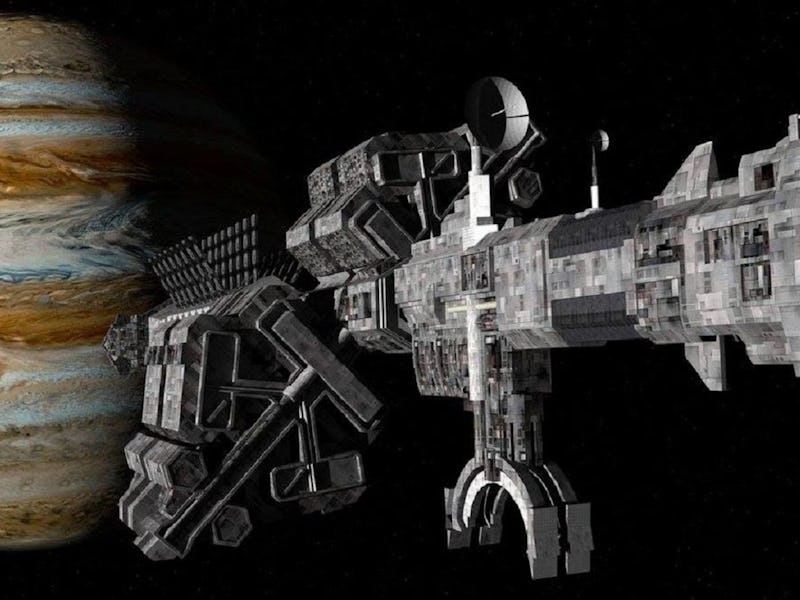You need to watch the most underrated sci-fi sequel on HBO Max ASAP
It's time to make contact.

It’s not an exaggeration to say that there are two eras of sci-fi movies: everything that came before 2001: A Space Odyssey and everything that came after. Ambitious sci-fi movies had been made before Stanley Kubrick’s 1968 masterpiece, but never at such a grand scale.
On every level, from the technical to the aesthetic to the philosophical, Kubrick challenged audiences with a whirlwind of startling sci-fi images, daring them to make sense of it all. Directors have been responding to this ultimatum for decades, delivering films like Contact and Arrival.
But did you know 2001 also earned a direct sequel? Called 2010: The Year We Make Contact, it came out in 1984 and was directed by Peter Hyams. The sequel is far less well-known than 2001, which is a shame because, while it’s not a revolutionary step forward for cinema in the vein of its predecessor, 2010 is a fine movie in its own right. Now that it’s streaming on HBO Max, here’s why you need to see 2001’s underappreciated sequel.
2001 is known for many strokes of brilliance, but its plot is not the element audiences met with the most acclaim. Watching Kubrick’s movie, it’s easy to forget that it’s actually an adaptation of an Arthur C. Clarke novel, as is 2010. Transcending story, 2001 moves through an immense series of setpieces, ranging from the monoliths at its beginning to HAL 9000’s “I’m sorry Dave, I can’t do that” hijacking and the startling ending sequences.
Roger Ebert noted the difficulty in following up such an open-ended project in his 2010 review, asking, “Did I really want to know (a) why HAL 9000 disobeyed Dave's orders? or (b) the real reason for the Discovery's original mission? or (c) what the monoliths were trying to tell us? Not exactly.”
While 2010 offers answers to many of its predecessor’s lingering enigmas, that’s not the only reason Hyams’ film exists. Instead, 2010 explores new concepts, like the Cold War. The audience learns that Discovery One, the mission explored in the first movie, has been deemed a failure and is still orbiting Jupiter, with Dave Bowman (Keir Duella) missing and presumed dead. Dr. Heywood Floyd (Roy Scheider), a minor character from 2001, took the fall for this catastrophe.
Exiled from the realm of academia, Floyd is visited by a Soviet agent who lets him know that Russia is planning a trip of its own to Jupiter, to see what exactly happened to Bowman. But given that Discovery was an American vessel, and that the Soviets are wary of the murderous HAL 9000, they’re hoping to make it a joint mission.
Helen Mirren in 2010: The Year We Make Contact.
It’s a dangerous undertaking. Soviet-US tensions have continued up to the present day in 2010, with a contentious dispute over Honduras threatening world peace (the conflict closely resembles the real-like Cuban Missile Crisis). But Floyd is able to convince his friends at the NCA (the film’s equivalent of NASA) that Americans need to be involved with this mission — and what’s more, that he should be one of them.
The others on board are technical experts: Walter Curnow (John Lithgow), an engineer, and Chandra (Bob Balaban), who has been studying HAL ever since 2001. Chandra’s studies are perhaps the only area in which this sequel stands a little too close to the original, given that he works with an intelligent computer called, wait for it, the SAL 9000.
But the time spent with SAL is short. Rather, the movie jumps ahead to the ship's arrival at Jupiter, where Floyd is awakened and meets the Russians. Most prominent among these new introductions is Tanya (Helen Mirren), but pleasantries are soon set aside in the name of scientific discovery: there are signs of life on one of the planet’s moons, Europa, including chlorophyll.
But as the space explorers try to investigate, an energy burst shoots out and destroys their probe, along with all its data. Tanya and the other Russians think this is an electrostatic discharge, but Floyd senses that something is trying to warn them away from Europa.
Roy Scheider and Natasha Shneider in 2010.
They turn toward the remains of the Discovery, still orbiting Jupiter. Perhaps concerned with viewers getting lost in the plot, the action is buffeted by Floyd’s recorded messages to his family back on Earth, explaining carefully what they’re trying to do and how they’re trying to do it. Onboard the Discovery, the crew reboots one of the great villains in movie history: HAL.
There are a few returning characters in 2010, and they’re employed to great effect. It’s hard to imagine anyone other than Douglas Rain voicing HAL’s creepy monotone, and although there are no lines as sinister as his refusal to open the pod bay doors, tension still emanates from whatever the hell is going on behind that unblinking red eye.
Keir Duella also returns as Bowman for a few key scenes, but the most important return has to come courtesy of the monoliths. The monoliths loom large over the entire US-Soviet mission, literally. A giant one hovers right above the joint mission, making the escalating crisis on Earth feel smaller and smaller.
Although 2010 was a financial success and was nominated for a number of Oscars, it will forever loom in the shadow of its big brother. But while it’s not a transcendental fever dream, it’s a good movie in its own right.
2010: The Year We Make Contact is now streaming on HBO Max.
This article was originally published on